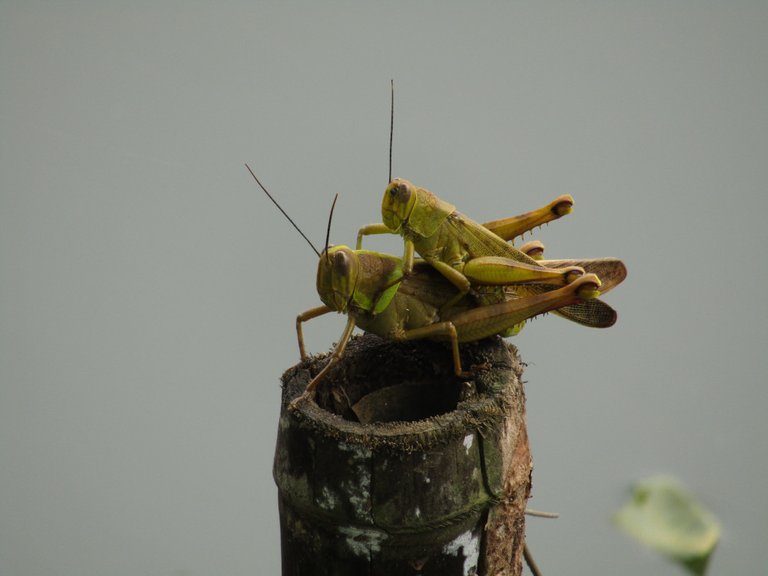Romansa - Facts About Grasshoppers

Dear all Hive users, this is not about NSFW but about a romance and facts of grashoppers. Do you know a grasshopper? How is its reproduction?
Facts About Grasshoppers
The green grasshopper is called Oxya serville. It is a herbivore. It eats leaves. Grasshoppers are insect pests.But did you know that grasshoppers contain a lot of protein and can be consumed by humans.There are several attempts to cultivate grasshoppers for bird feed and even for human consumption.
Reproduction
Grasshoppers reproduce by laying eggs. Male grasshoppers enter sperm through the ovipositor, which is the female grasshopper's genitals. Grasshoppers reproduce by laying eggs. Male grasshoppers enter sperm through the ovipositor, which is the female grasshopper's genitals. Meanwhile, the male sex is called Aedeagus.
Sperm will be distributed to the ovarium for fertilization. A female grasshopper can produce up to 300 eggs.
After the eggs in the ovarium are ready, the female grasshopper will lay the eggs under the ground about 1 or 2 inches deep. The eggs are protected in a pea-like envelope until they hatch after a few weeks. In subtropical countries, the eggs will hatch after winter when the weather is warm. However, if there is bad weather, grasshopper eggs can become dormant for 9 months.

These are some facts about grasshoppers.
Those pictures are from my collection. I took the photos when I walked out on the side of the lake. There are many grasshoppers in the grassing area.

Grasshoppers are a promising business opportunity because grasshopper meat can be consumed or used to feed birds. This opportunity is still not exploited by most people in our country. One of the obstacles is knowledge about nurseries and artificial habitats so that grasshoppers can breed like in the wild life. I only discovered the grasshopper fact after taking the photos for this post.
Refference : https://jenis.net/cara-berkembang-biak-belalang/
Note : All the images are my collection

https://twitter.com/ahmadfz1/status/1478976322403594240
The rewards earned on this comment will go directly to the person sharing the post on Twitter as long as they are registered with @poshtoken. Sign up at https://hiveposh.com.
We call this belalang kunyit, or belalang juta. However, I haven't see a swarm of them yet 😐😐
it could be because the color is little bit yellow so it is called belalang kunyit
Hey bro.... I really thank you for sharing
Thanks for stoping
I think this guy has an affliction for larger ladies 😉. I am just glad we humans don't have spikes on our legs, that would make mating much more awkward.
lol... yes the male grasshoppers are smaller than the female , that is the problem , by the way, I miss your regular posts, it has been a week no updates from your stories.
I've just arrived back in Cambodia, still not settled yet, but today is the first day I was able to plug in my computer and sit down with wi-fi. Later on tonight I'll hopefully be close to caught up with curation, then be able to publish an @asean.hive post. After that hopefully I can begin to share some Cambodian stories 😄.
that great news of your arriving in Cambodia
⋆ ᴛʜᴇ ᴘʟᴀᴄᴇ ғᴏʀ sᴏᴜᴛʜᴇᴀsᴛ ᴀsɪᴀɴ ᴄᴏɴᴛᴇɴᴛ ᴏɴ ʜɪᴠᴇ
⋆ sᴜʙsᴄʀɪʙᴇ ᴛᴏ ᴛʜᴇ ᴀsᴇᴀɴ ʜɪᴠᴇ ᴄᴏᴍᴍᴜɴɪᴛʏ
⋆ ғᴏʟʟᴏᴡ ᴛʜᴇ ᴀsᴇᴀɴ ʜɪᴠᴇ ᴄᴏᴍᴍᴜɴɪᴛʏ ᴠᴏᴛɪɴɢ ᴛʀᴀɪʟ
⋆ ᴅᴇʟᴇɢᴀᴛɪᴏɴ ʟɪɴᴋs 25 ʜᴘ⇾50 ʜᴘ⇾100 ʜᴘ⇾500 ʜᴘ⇾1,000 ʜᴘ
good catch. very rare to get insects that are mating.
Thanks, it is true, I got the pics when I was walking out with my kids.